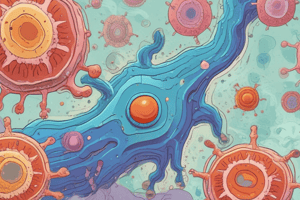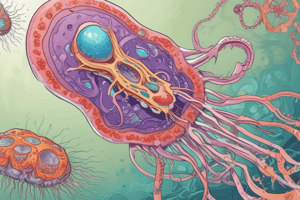Podcast
Questions and Answers
What is the primary causative agent of amoebic dysentery?
What is the primary causative agent of amoebic dysentery?
Which diagnostic method involves detecting parasite antigens in the stool?
Which diagnostic method involves detecting parasite antigens in the stool?
What do E.histolytica parasites commonly form during their life cycle?
What do E.histolytica parasites commonly form during their life cycle?
Which test might be necessary for confirming the diagnosis in more severe cases of E.histolytica infection?
Which test might be necessary for confirming the diagnosis in more severe cases of E.histolytica infection?
Signup and view all the answers
What happens when E.histolytica cysts are ingested?
What happens when E.histolytica cysts are ingested?
Signup and view all the answers
What is the primary mode of transmission for E.histolytica?
What is the primary mode of transmission for E.histolytica?
Signup and view all the answers
What factor can increase the risk of E.histolytica infection related to contaminated water supplies and fruits?
What factor can increase the risk of E.histolytica infection related to contaminated water supplies and fruits?
Signup and view all the answers
Which clinical manifestation is characterized by severe diarrhea, abdominal pain, and mucus or blood in the stool?
Which clinical manifestation is characterized by severe diarrhea, abdominal pain, and mucus or blood in the stool?
Signup and view all the answers
Which drug is an antiprotozoal medication that interferes with the parasite's DNA synthesis?
Which drug is an antiprotozoal medication that interferes with the parasite's DNA synthesis?
Signup and view all the answers
What type of therapy for E.histolytica infections involves using Metronidazole or tinidazole for seven consecutive days?
What type of therapy for E.histolytica infections involves using Metronidazole or tinidazole for seven consecutive days?
Signup and view all the answers
How does Fasciola hepatica primarily affect intermediate hosts?
How does Fasciola hepatica primarily affect intermediate hosts?
Signup and view all the answers
What is the main role of snails in the life cycle of Fasciola hepatica?
What is the main role of snails in the life cycle of Fasciola hepatica?
Signup and view all the answers
Where do adult liver flukes of Fasciola hepatica develop after infecting mammals?
Where do adult liver flukes of Fasciola hepatica develop after infecting mammals?
Signup and view all the answers
What symptoms characterize acute fasciolosis in individuals with Fasciola hepatica infection?
What symptoms characterize acute fasciolosis in individuals with Fasciola hepatica infection?
Signup and view all the answers
What diagnostic method is commonly used for detecting parasite antigens in stool samples of Fasciola hepatica-infected individuals?
What diagnostic method is commonly used for detecting parasite antigens in stool samples of Fasciola hepatica-infected individuals?
Signup and view all the answers
What is a common symptom of chronic fasciolosis as the fluke population grows?
What is a common symptom of chronic fasciolosis as the fluke population grows?
Signup and view all the answers
Which imaging technique is used to reveal the presence of liver flukes and their associated lesions?
Which imaging technique is used to reveal the presence of liver flukes and their associated lesions?
Signup and view all the answers
What is the primary treatment for Fasciola hepatica infection that is available in oral and injectable forms?
What is the primary treatment for Fasciola hepatica infection that is available in oral and injectable forms?
Signup and view all the answers
Which method is used to detect liver fluke antigens in fecal samples?
Which method is used to detect liver fluke antigens in fecal samples?
Signup and view all the answers
What is one of the less effective alternatives to triclabendazole for treating Fasciola hepatica infection?
What is one of the less effective alternatives to triclabendazole for treating Fasciola hepatica infection?
Signup and view all the answers
Study Notes
Entamoeba histolytica: A Comprehensive Overview
Entamoeba histolytica, a protozoan parasite, is the primary causative agent of a severe and often fatal disease called amoebic dysentery or amebiasis. This article will explore the diagnosis, pathogenesis, transmission, and treatment strategies for E. histolytica infections.
Diagnosis
Diagnosing E. histolytica infection typically involves several tests to confirm the presence of the parasite and rule out other conditions with similar symptoms. These diagnostic methods include:
- Microscopic examination: Examining a stool sample under a microscope for the presence of E. histolytica trophozoites, cysts, or other parasites.
- Antigen detection: Detecting parasite antigens in the stool using enzyme-linked immunosorbent assay (ELISA) tests.
- Molecular tests: Amplifying specific DNA sequences using polymerase chain reaction (PCR) to confirm the presence of E. histolytica.
- Serological tests: Detecting antibodies against E. histolytica in the blood.
For more severe cases, additional tests like colonoscopy or biopsy might be necessary to confirm the diagnosis.
Pathogenesis
E. histolytica parasites commonly form cysts during their life cycle, which can survive outside the host for extended periods. When ingested, the cysts dissolve in the small intestine, releasing trophozoites that invade the intestinal lining. Trophozoites can then traverse the intestinal wall, leading to inflammation and ulceration of the large intestine and rectum.
E. histolytica can cause a wide range of clinical manifestations, including:
- Amebic dysentery: Characterized by severe diarrhea, abdominal pain, and mucus or blood in the stool.
- Extra-intestinal amebiasis: Involving the liver, brain, lungs, or skin, and resulting in symptoms such as abdominal pain, weight loss, and fever.
Transmission
E. histolytica is primarily transmitted through the ingestion of contaminated food or water. The following factors can increase the risk of infection:
- Fecal-contaminated food or water: Contaminated water supplies, fruits, or vegetables can harbor E. histolytica cysts.
- Person-to-person transmission: Direct contact with fecal material from an infected individual or contaminated surfaces.
- Poor sanitation: Lack of proper sanitation and hygiene can lead to an increased risk of infection.
Treatment
The primary treatment for E. histolytica infections involves medications that target the parasite's life cycle. The most commonly used drugs include:
- Metronidazole: An antiprotozoal drug that interferes with the parasite's DNA synthesis.
- Tinidazole: Another antiprotozoal drug, similar to metronidazole but with fewer side effects.
Treatment strategies may include:
- Single-dose therapy: Metronidazole or tinidazole for three days.
- Three-day therapy: Metronidazole or tinidazole for three consecutive days.
- Seven-day therapy: Metronidazole or tinidazole for seven consecutive days.
In cases of severe or extra-intestinal amebiasis, a longer course of treatment or other medications may be required.
Prevention measures, such as proper sanitation and hygiene, can significantly reduce the risk of E. histolytica infections. Travelers to regions with a high risk of amebiasis should also take precautions to avoid consuming contaminated food or water.
Studying That Suits You
Use AI to generate personalized quizzes and flashcards to suit your learning preferences.
Description
Explore the diagnosis, pathogenesis, transmission, and treatment strategies for Entamoeba histolytica (E. histolytica) infections. Learn about diagnostic methods, the parasite's life cycle, clinical manifestations, transmission factors, and primary treatment options.





